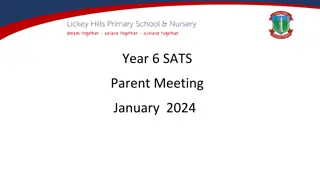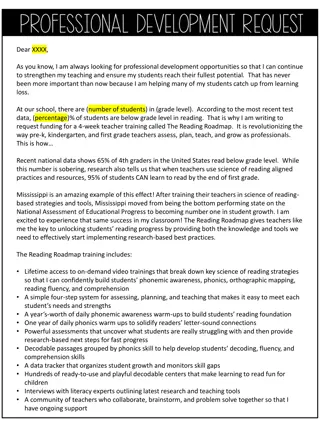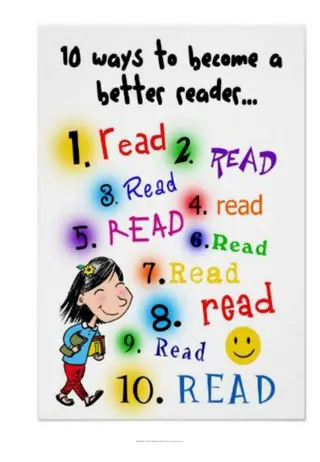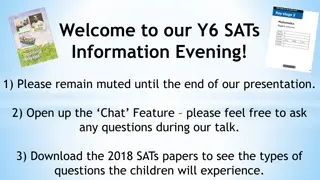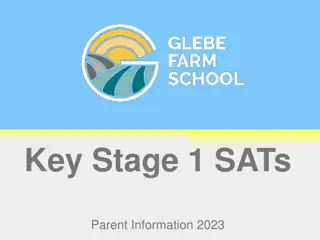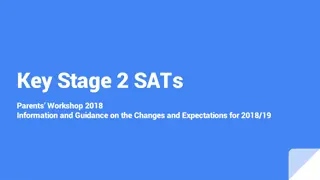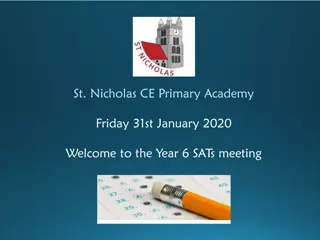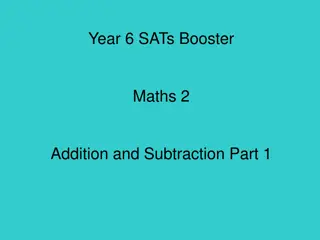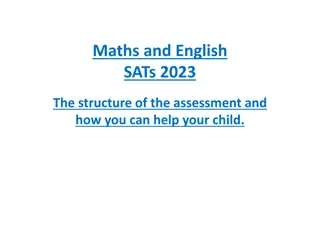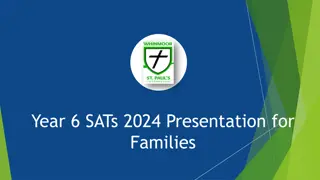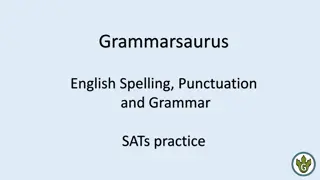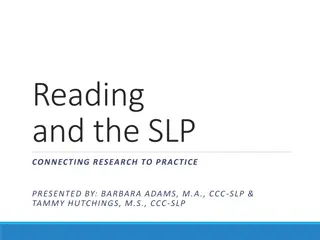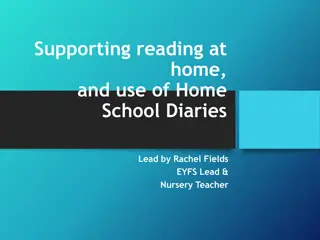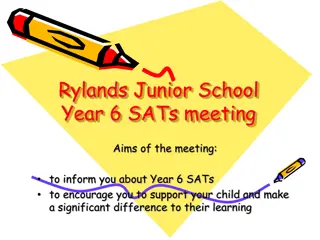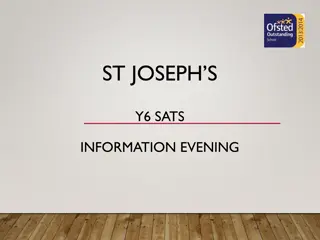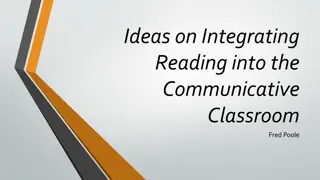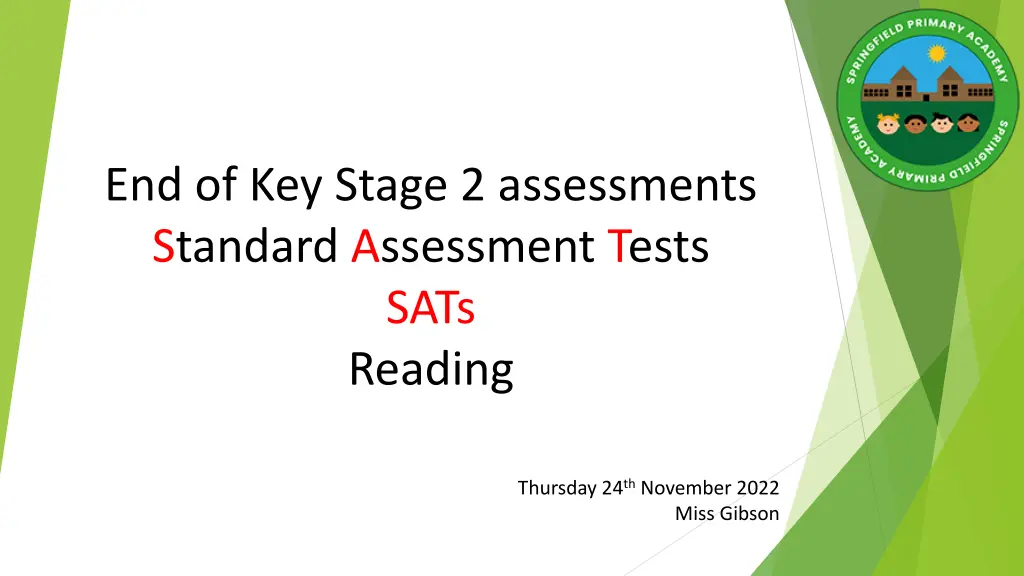
Key Stage 2 SATs Reading Assessment Information
Learn about the Key Stage 2 SATs Reading test, including assessment details, reading domains, and sample questions. Find out how children are assessed in reading and discover strategies to support them at home. Explore the importance of reading domains and key reading skills evaluated in the test.
Download Presentation

Please find below an Image/Link to download the presentation.
The content on the website is provided AS IS for your information and personal use only. It may not be sold, licensed, or shared on other websites without obtaining consent from the author. If you encounter any issues during the download, it is possible that the publisher has removed the file from their server.
You are allowed to download the files provided on this website for personal or commercial use, subject to the condition that they are used lawfully. All files are the property of their respective owners.
The content on the website is provided AS IS for your information and personal use only. It may not be sold, licensed, or shared on other websites without obtaining consent from the author.
E N D
Presentation Transcript
End of Key Stage 2 assessments Standard Assessment Tests SATs Reading Thursday 24th November 2022 Miss Gibson
Aims Inform Inform parents of dates for tests. Provide information about the reading test paper. Provide Provide Provide strategies to support at home.. Provide opportunities for parents to look at examples of test papers. Provide
How are children assessed in reading? Children in Y6 sit one reading paper that lasts for an hour. The paper assesses the ability of a child to read accurately and fluently as well as range of reading skills called, Reading Domains .
Reading Domains Reading domains were first introduced in 2016 in the national curriculum test framework. Reading domains highlight the elements of that national curriculum that will be assessed as part of the English reading test in the KS2 SATs.
2a: Give/explain the meaning of words in context What does this... word/phrase/sentence... tell you about ... character/setting/mood etc? Highlight a key phrase or line. By writing a line in this way, what effect has the author created? In the story, 'x' is mentioned a lot. Why?
2b: Retrieve and record information/ identify key details Where does the story take place? When did the story take place? What do you think is happening here?
2c: Summarise main ideas from more than one paragraph What's the main point in this paragraph? Which is the most important point in these paragraphs? How many times is it mentioned? Sort the information in these paragraphs. Do any of them deal with the same information?
2d: Make inferences from the text/explain and justify inferences with evidence from the text What makes you think that? Which words give you that impression? How do you feel about...?
2e: Predict what might happen from details stated and implied What do you think will happen next? What do you think [character] will do now? How do you think the story will end?
2f: Identify/explain how narrative content is related and contributes to meaning as a whole. Draw lines to match each section to its main content. Match each part of the story with the correct quotation from the text.
2g: Explain how meaning is enhanced through the choice of words or phrases Why do you think the author chose to use this word to describe...? Why did the author choose this simile? What is the effect of alliteration in this sentence?
2h: Make comparisons within the text Find and copy the words where [character]'s mood changes. How does [character]'s attitude change? How does [character]'s feelings change?
What does the expected standard look like in practice? read age-appropriate books with confidence and fluency (including whole novels) read aloud with intonation that shows understanding work out the meaning of words from the context explain and discuss their understanding of what they have read, drawing inferences and justifying these with evidence predict what might happen from details stated and implied retrieve information from non-fiction evaluate how authors use language, including figurative language, considering the impact on the reader summarise main ideas, identifying key details and using quotations for illustration make comparisons within and across books.
SATs Reading Comprehension Test what to expect. The extracts in the reading booklet will not be linked by a theme. The booklet will contain three or four different texts. The least demanding text will come first with the following texts increasing in level of difficulty Children will have a total of one hour to read the texts and complete the questions at their own pace.
The reading answer booklet what to expect. Approximately 35 to 40 questions (totalling 50 marks) Short, closed responses (such as multiple choice and matching questions). Shorter, open response items Longer, open response items that require children to explain and comment on the texts in order to demonstrate a full understanding Questions are worth 1, 2 or 3 marks.
Example Question Some questions are followed by a short line or box. This shows that you only need to write a word or a few words in your answer. 1. Look at the paragraph beginning: Glancing nervously... Find and copy one word meaning relatives from long ago. _______________________________________________ 1 mark
Example Question Some questions are followed by a few lines. This gives you space to write more words or a sentence or two. milled around in bewilderment (page 8) Explain what this description suggests about the baby warthogs. ____________________________________________________ ____________________________________________________ ________________________________________________
Example Question Some questions are followed by a large box. This shows that a longer, more detailed answer is needed to explain your opinion. Do you think that Martine will change her behaviour on future giraffe rides? Tick one. Yes No Maybe Explain your choice fully, using evidence from the text. (3 marks) ______________________________________________________ ______________________________________________________ ______________________________________________________
Example Question For some questions you need to tick, draw lines to, or circle answers. It is important to read the instructions carefully. What was revealed at the end of the story? Tick one. Oliver was keeping a secret. The monument was damaged. The two families were still enemies. Maria s family did not win the throne.
How can I help my child? Regular attendance at school Be ready to learn each day at school A quiet, organised place to work at home Completing homework on time ASK ASK ASK if you need help! Revision at home Multiplication facts/spelling lists Reading and reading at speed
Helping at home with their reading Support homework and reading at home Read to and with your child and discuss what they have read Ask questions about their reading 1) What ave you read today? 2)What do you think will happen next? Why? Develop their vocabulary and understanding through everyday experience Talk about what they have been learning in school Join and visit the local library Ask their teacher if there is anything you are unsure of Offer lots of encouragement
Useful websites http://www.satspapers.org.uk/ http://www.bbc.co.uk/bitesize/ks2/ www.wordsforlife.org Virtual Library available on the school website: https://www.springfieldacademy.org.uk/ https://www.lovereading4kids.co.uk/


